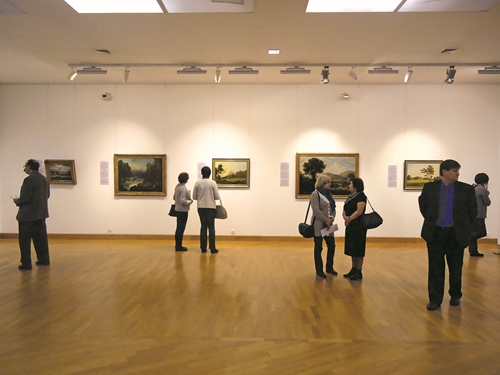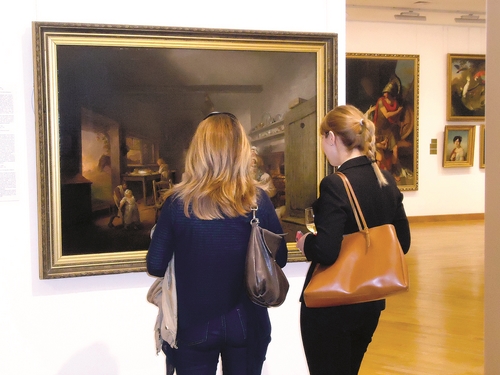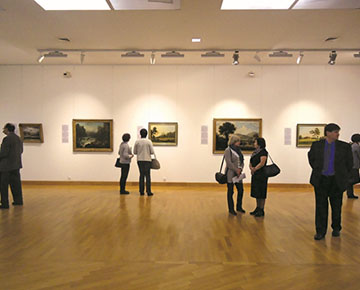The Touch of Britain exhibition presents pictorial works, as well as decorative-and-applied arts, from the UK’s Government Art Collection, the National Art Museum of Belarus and the National History Museum of Belarus.

Beautiful British art on show at National Art Museum exhibition
Looking at the past five centuries, it’s easy to see how feudal wars impeded the artistic traditions of Britain. The Puritan movement, with its iconoclastic ideas, was an obstacle to the development of the national painting school, with religious painting hardly represented in Protestant England. The 17th century was marked by the gradual development of portraiture, mainly in miniature, while the following century saw British artists working intensively and fruitfully, as if making up for lost time. The 18th century was a time of brilliant blossoming for British culture. Alongside France, the UK set trends in European artistic taste, with the English culture of everyday life, interior decoration, and landscape art having the greatest impact on the continent.
The founder of the national painting school and the greatest figure of British art in the first half of the 18th century, to the middle of the century, was William Hogarth. His bold realism influenced a variety of stylistic phenomena, focusing on ‘addressing nature’ and ‘trusting feelings’. He created works reflecting moments in everyday life and was the first British artist to use the theme of theatre: a subject dear to the English from Shakespearean times. He was a friend of the prominent actor of his day, David Garrick.
The exhibition includes an engraved reproduction of one of Hogarth’s paintings devoted to the final scene of the play The Beggar’s Opera, by British dramatist John Gay. The premiere was held in London in January 1728. From the collection of the National History Museum of Belarus, there is also a print by the famous English artist and poet William Blake.

In the 18th century, English art concentrated on portraiture, while the rest of Europe popularised historical and mythological themes. In Britain, portraiture reflected historical notions of the importance of man and the rich traditions and heritage of foreign masters. The portrait genre dominates at the Royal Academy of Arts, opened in London in 1768, whose first president was Joshua Reynolds: one of the foremost representatives of English portraiture from the 18th century.
Most paintings by English portrait painters in the second half of the 18th century were characterised by the Age of Enlightenment’s appreciation of man’s personal qualities. They showed brilliant painting techniques, free brushwork and saturated colours. At the current exhibition, there are several engravings by English masters, from the archive of the National Art Museum of Belarus.
In the 19th century, portraiture was replaced by landscape painting, which reached unprecedented popularity. In the 18th century, ‘topographical’ landscapes (showing local landmarks) grew in popularity in Britain. On show at the current exhibition are works by Luke Sullivan, from the National Art Museum of Belarus, as well as canvases by George Frederick Buchanan, from the UK’s Government Art Collection, which reflect the continuing development of this tradition in the 19th century.
English landscape painting from the second half of the 18th and early 19th century is characterised by stronger emotional development. John Glover was famous for developing traditions of ‘classical’ English landscape painting, in the manner of Claude Lorrain. The exhibition is showcasing his Ullswater with Goldrill Bridge, from the Government Art Collection, which shows a view of the English Lake District. Classical landscape traditions are also reflected in Charles Towne’s Falls of Tummell, Perthshire, from the British collection.

19th century England became home to a new generation of European landscape painting, characterised by reproducing the beauty of nature: as pursued by various European art schools in the first quarter of the century. English artists developed this concept several decades before the continental European painters, perceiving the natural landscape as symbolic of ‘good old England’. English artists in this genre who are best known are Joseph William Turner and John Constable. Landscape painting was a great achievement of English art at this time and made the most important contribution to the development of European contemporary painting.
British genre painting is not associated with mainline British artistic development. Like portraiture, genre art originated in Hogarth’s works, dating back to the first half of the 18th century, exploring humorous or sentimental scenes from everyday life. In the 1770-1780s, English literature and, later, painting were marked by English village scenes. George Morland was one of the first English artists to depict rural settings and was a master of the domestic scene, being an outstanding painter of landscapes and animals. He loved to paint picturesque cottages and their inhabitants, as in Return of a Farmer from the Hunt, which is on display at the current exhibition, from the collection of the National Art Museum of Belarus.
The domination of painting over all other forms of art was distinct to British art in the 18th-19th century. The formation of the English graphic school, as well as the figurative school, was associated with Hogarth’s name and inspired a revival of interest in engraved works, which influenced the development of printing and graphic art. The 18th century brought popularity to the national painting school and to ‘reproduction prints’, with English engravers working closely with fine artists to turn original paintings into printing plates, finding new nuances. The Minsk exhibition has some wonderful examples of reproduction graphic works: The Temptation of St. Anthony by Demons, by the well-known engraver, painter and publisher Arthur Pond, and The Adoration of the Shepherds, by Gillbank Haveill, both from the collection of the National Art Museum of Belarus.
The 18th and 19th century also brought popularity to British decorative-and-applied arts, in particular porcelain and ceramics. Sales were forthcoming across Europe, with the Staffordshire potteries — the oldest ceramic centre in England — of particular note. The current exhibition presents several examples of English ceramics, dating from the 19th century, mainly made in Staffordshire.

In the 19th century, British ceramic companies began using transfer printing to decorate their wares, with Russian themes to the fore. A series of plates featuring well-known St. Petersburg landmarks was produced at the G. L. Ashworth & Brothers pottery, with two plates from this series on show at the Minsk exhibition: St. Isaac’s Cathedral, and The Bolshoi Theatre in St. Petersburg, from the collection of the National Art Museum of Belarus.
One of the largest British ceramic manufacturers of the second half of the 19th century was Brown-Vesthed, Moore & Co., which supplied the British royal family and the Russian Imperial Court. Motifs of faience and porcelain tableware included a popular floral design.
Most of paintings on display in Minsk are on loan from the UK Government Art Collection, founded in 1898 and now comprising over 13,000 works by English masters, dating from the 16th century to the present day. Exhibits are spread across various government institutions, primarily in the UK but also abroad. The UK Government Art Collection works to promote exhibitions around the world.
Despite the ‘chamber’ exhibition format, the presented works give an idea of the uniqueness and originality of the English art school of the 18th and 19th century.
By Veniamin Mikheev











